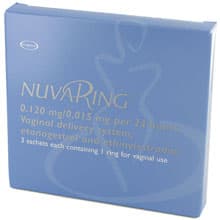Contraceptive Ring: start your consultation
- 1. Answer the online medical questions
- This helps our doctors to decide which treatment is safe for you.
- 2. Select your treatment
- You will see a list of recommended treatments. You can select the one you prefer.
- 3. Checkout and delivery
- Once you’ve completed the checkout, our doctors will review your answers. If all is safe, you will receive your treatment tomorrow.
Available Treatment(s)

- Almost 100% effective at preventing pregnancy
- Buy NuvaRing online with no doctors appointment
- Free next day delivery
Contraceptive Ring
Information about the vaginal ring
The contraceptive ring is a relatively new form of birth control and consists of a flexible ring that is inserted into the vagina and slowly releases hormones into the body which prevent pregnancy. It's popular because unlike oral contraceptives, it doesn't need to be taken every day.
The ring is inserted for three weeks before being removed for a seven-day break; and during this time it will still protect you from unplanned pregnancies. After this week-long break, another ring will need to be inserted for protection to continue. It's become extremely popular and it's estimated that 1.5 million women use the contraceptive ring worldwide.
How does the contraceptive ring work?
The contraceptive ring works in a very similar way to combined contraceptive pills and the contraceptive patch. It contains two artificial hormones, oestrogen and progestogen, which it releases into the body during the three weeks it's inserted. The first hormone prevents ovulation by "tricking" the body into believing this has already occurred, while the second thickens the cervical mucus, stopping sperm from entering the womb. While it's believed the progestogen also stops the womb lining from thickening, like other contraceptives, there is no evidence that proves this.
Is the contraceptive ring easy to use?
The contraceptive ring is incredibly easy to use. Once removed from the foil patch it comes in, simply squeeze the flexible ring between your thumb and index finger before inserting it into your vagina. To remove, gently hook your finger under the rim and slowly pull it out. The exact position within the vagina will not affect the level of protection, so it can shift around and be re-inserted as necessary and according to what feels comfortable.
What are the advantages of the contraceptive ring?
The contraceptive ring's biggest advantage is that it only needs to be inserted once a month. And because this can be done alone, it is an extremely convenient and easy form of contraception. This also means that any severe side effects can be avoided once they present themselves by simply removing the device.
In terms of sexual activity, most people do not notice the ring's presence during sex. If however the contraceptive ring is uncomfortable, it can be removed if you prefer but should not stay out for more than three hours.
It's also been known to help improve acne, reduce menstrual cramps and give some protection against pelvic inflammatory disease, as well as ovarian cysts or uterine and ovarian cancers.
What are the disadvantages of the contraceptive ring?
The biggest disadvantage is that sometimes the contraceptive ring can move out of place. This is unlikely, but can happen if the muscles relax too much. If it does happen, the ring can simply be rinsed with lukewarm water and reinserted. Remember that it should not be out longer than three hours. If this happens, you should reinsert it but use another contraceptive for seven days.
Keeping the contraceptive ring stored may also prove difficult if you wish to have several to hand as these must be refrigerated. If not stored correctly, the ring will expire after four months.
Some women have also reported mild discomfort in their vaginas from using the ring, and because the dosage of hormones is the highest in this form of birth control; if you experience any side effects they may be a lot stronger than other treatments.
What side effects can it cause?
The contraceptive ring has been known to cause abdominal pain, vaginal discomfort, reduced libido, itching in the genitalia and weight gain. More uncommon side effects may include mood changes, swollen abdomen, muscle spasms, pain or bleeding during intercourse or while urinating and disturbed vision. If you should experience any of these, you should remove the contraceptive ring and consult your doctor for assistance and alternate treatments.
Who can use the contraceptive ring safely?
Women who have a medical history that includes heart attacks, a stroke, blood clots, high blood pressure, and heart or rhythm disorders should not use the contraceptive ring for birth control. If you are uncertain about which condition is relevant to your safety, you should raise any medical concerns to your doctor when being prescribed this form of contraception.
medical form
medication
prescription
from pharmacy
